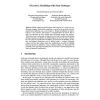Free Online Productivity Tools
i2Speak
i2Symbol
i2OCR
iTex2Img
iWeb2Print
iWeb2Shot
i2Type
iPdf2Split
iPdf2Merge
i2Bopomofo
i2Arabic
i2Style
i2Image
i2PDF
iLatex2Rtf
Sci2ools
MODELS
2007
Springer
2007
Springer
Piecewise Modelling with State Subtypes
Abstract. Models addressing both structure and behaviour of a system are usually quite complex. Much of the complexity is caused by the necessity to distinguish between different cases, such as legal vs. illegal constellations of objects, typical vs. rare scenarios, and normal vs. exceptional flows of control. The result is an explosion of cases causing large and deeply nested case analyses. While those based on the kinds of objects involved can be tackled with standard dynamic dispatch, possibilities for differentiations based on the state of objects have not yet been considered for modelling. We show how the handling of class and state-induced distinctions can be unified under a common subtyping scheme, and how this scheme allows the simplification of models by splitting them into piecewise definitions. Using a running example, we demonstrate the potential of our approach and explain how it serves the consistent integration of static and dynamic specifications.
| Added | 08 Jun 2010 |
| Updated | 08 Jun 2010 |
| Type | Conference |
| Year | 2007 |
| Where | MODELS |
| Authors | Friedrich Steimann, Thomas Kühne |
Comments (0)

